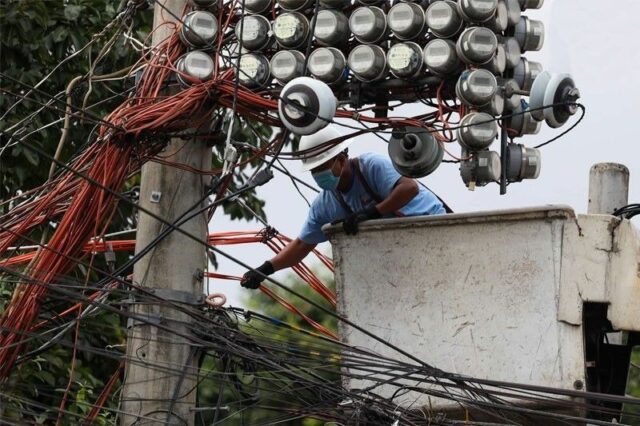By Sheldeen Joy Talavera, Reporter
WHILE the Philippines is advancing in conventional and renewable energy development, some power companies are also preparing for the country’s nuclear energy future by developing local expertise.
Kenneth S. Tulagan, a 29-year-old distribution engineer at Manila Electric Co. (Meralco), is part of this effort.
Mr. Tulagan graduated with a bachelor’s degree in electrical engineering from the Technological University of the Philippines – Manila in 2017, took his licensure exam, and joined Meralco the same year. He was selected for Meralco’s Filipino Scholars and Interns on Nuclear Engineering (FISSION) program where they were sent to the United States and China to embark on further studies.
 Upon their return to the Philippines, these scholars will be reintegrated into Meralco, taking on roles in its nuclear power generation unit.
Upon their return to the Philippines, these scholars will be reintegrated into Meralco, taking on roles in its nuclear power generation unit.
“There’s a saying that curiosity is an engineer’s best asset. When the program was introduced, I became curious about how nuclear engineering works. With that curiosity, my inner self wants to study the nuclear engineering field more since it’s new here in the Philippines,” Mr. Tulagan said in an interview with BusinessWorld.
Mr. Tulagan is currently pursuing a Master of Engineering in Energy Systems at Harbin Engineering University in China.
“I think the Philippines has good backend support in nuclear energy development since we have a very skilled workforce that can help build the atomic power plant compound itself and also great minds of engineers and scientists that could help the transmission of power from a nuclear power plant facility to our electrical grid,” he said.
Mr. Tulagan said the Philippines is set to benefit from utilizing nuclear energy as it could help reduce rotational brownouts and augment energy supply during summer and peak season.
“Nuclear energy can play a key role in ensuring a reliable and sustainable energy supply for the Philippines,” said Amiela T. Nicodemus, a 27-year-old distribution engineer at Meralco who is also a FISSION program scholar.
“As the country’s demand for electricity continues to rise, nuclear power provides a stable, baseload energy source that can complement intermittent renewables like solar and wind. This helps to maintain grid stability while reducing reliance on fossil fuels,” she added.
Ms. Nicodemus has been sent to the University of Illinois Urbana-Champaign in the US where she is starting to gain a strong foundation in nuclear engineering, probabilistic risk analysis, and renewable energy systems.
“I believe nuclear energy has great potential to meet the Philippines’ growing energy needs,” she said. “With increasing demand for electricity driven by our growing economy, nuclear energy can provide reliable, low-carbon baseload power.”
Ronnie L. Aperocho, executive vice-president and chief operating officer of Meralco, said that the company is committed to building “a highly capable local workforce in leading the Philippines into a nuclear-powered future,” part of its Nuclear Energy Strategic Transition program.
“Through FISSION, we aim to develop industry-ready experts on nuclear engineering who will take a transformative role in addressing the complex challenges of nuclear energy development in the country,” he said.
Under the Department of Energy’s Philippine Nuclear Energy Program, the government aims to have commercially operational nuclear power plants by 2032 with at least 1,200 megawatts (MW), and 2,400 MW by 2035.
An independent nuclear regulatory commission is targeted to be fully operational by 2026, including the determination of the government’s role through policies and/or legislation.
Thus, the necessary laws on the nuclear legal and regulatory framework must be in place by 2025. By 2027, a legal framework for the mechanism for power contracting should be established.
The International Atomic Energy Agency (IAEA), the world’s center for cooperation in the nuclear field, said in its assessment that the Philippines has made “significant progress to address most of the recommendations and suggestions and has adopted a national position for a nuclear energy program.”
In its Follow-Up Integrated Nuclear Infrastructure Review (INIR), the mission team indicated, however, that further work is needed to finalize the Philippines’ nuclear power strategy and to complete necessary studies for future activities related to the electrical grid, industrial involvement, and national legislation.
Patrick T. Aquino, director of the Energy department’s Energy Utilization Management Bureau, said that the development of nuclear energy in the Philippines will be driven by the private sector, with “clear support from the government.”
“We remain optimistic about reaching our targets. The results of the just concluded Follow-Up INIR Mission from the IAEA indicate that substantial progress has been made in our Nuclear Energy Program,” Mr. Aquino said.
The advantage of nuclear energy is that it is high density and is “90% available,” according to Carlo A. Arcilla, executive director of the Philippines Nuclear Research Institute.
“Nuclear can actually back up renewables. They should not be pitted against each other,” Mr. Arcilla said via phone call.
He said that nuclear energy is needed as other baseload technologies such as coal and liquefied natural gas are import-reliant, which is “very expensive” due to the Russia-Ukraine war.
“Mahal na nga ang kuryente natin, mas magmamahal pa (Our electricity is already expensive, and it will become even more expensive). The baseload that can actually bridge the gap, without emissions, is nuclear, but the issue there is it will take time,” Mr. Arcilla said.
While nuclear energy is still young for the Philippines, its workforce is deemed capable of meeting the demands of the specialized field through proper training and international partnerships.
“The Filipino workforce is primed for nuclear energy projects. From our pool of semi-skilled workers, engineers and scientists, the Filipino can be retooled to meet the requirements of the nuclear sector,” Mr. Aquino said.
Meralco’s Mr. Aperocho said that the Filipino workforce is “uniquely positioned to excel in nuclear energy development.”
“With our technical acumen, adaptability, and innovative culture, Filipinos have consistently demonstrated the capacity to master complex technologies,” he said.
The Meralco executive said that programs like FISSION would unlock the potential of Filipinos by providing “exceptional education and meaningful learning experiences on nuclear technologies globally.”
“We see our scholars and engineers as the forerunners of the country’s nuclear energy ambitions. Their technical expertise, coupled with diligence and collaboration, will enable the Philippines to overcome the challenges of adopting nuclear energy,” Mr. Aperocho said.
“I am confident that with the right training and global partnerships, the Filipino workforce will not only meet but exceed the demands of this highly specialized field, driving the country toward energy security and sustainability,” he added.




















